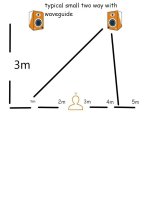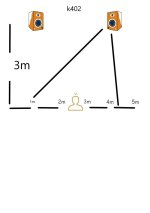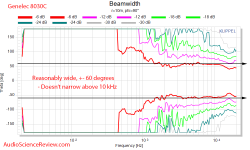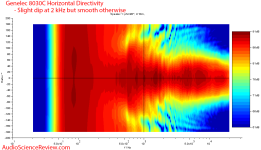Yes, ubacch is "dont move your head" system, one mans system, just like electrostatic speakers
For social events, that "everybody at the sofa" has something to listen to, different system, different speakers are needed
For social events, that "everybody at the sofa" has something to listen to, different system, different speakers are needed
Little bit more about the original question, Art mentioned " That said, the K-402 pattern control is far more narrow than any typical front-loaded speaker."
I made two pictures,
Example 1 has typical small two way speaker with waveguide. Its well made and starts to have 60° (-6db) at 1khz until 20khz
Example 2 is k-402 horn as mentioned before
Listening distance is 3 meters
Room width at listening place is 5m
On approxmation, how wide the coverage gets with Example 1 speaker at listening place and how much less on example 2 k402 speaker.
Just a rough estimate is enough
I made two pictures,
Example 1 has typical small two way speaker with waveguide. Its well made and starts to have 60° (-6db) at 1khz until 20khz
Example 2 is k-402 horn as mentioned before
Listening distance is 3 meters
Room width at listening place is 5m
On approxmation, how wide the coverage gets with Example 1 speaker at listening place and how much less on example 2 k402 speaker.
Just a rough estimate is enough
Attachments
Both angles in your pictures are the same, around 50 degrees, while the K-402 is around 90 degrees and your theoretical "typical small" speaker is said to be 60 degrees.I made two pictures,
Example 1 has typical small two way speaker with waveguide. Its well made and starts to have 60° (-6db) at 1khz until 20khz
Example 2 is k-402 horn as mentioned before
Listening distance is 3 meters
Obviously, 90 degrees covers a wider area (at any distance) than 60 degrees, at 3 meters from the source the 60 degree covers roughly 3 meters @-6dB, the 90 degree around 4.5 meters.
The "small" speaker's horn would be over 445mm (17.5") wide to have ~60 degree horizontal coverage pattern at 1000 Hz. The JBL 2385 (nominal 60 x40) horn expands to 70 degrees at 1kHz:
Regardless of the speaker's coverage angle, you can reduce the room's influence simply by moving the listening position closer to them, which increases the direct to reflected sound ratio.
As David Griesinger wrote in The Importance Of The Direct To Reverberant Ratio In The Perception Of Distance, Localization, Clarity, and Envelopment:
https://www.ioa.org.uk/system/files...io_in_the_perception_of_distance_localisa.pdf
“The ability to hear the Direct Sound – the sound energy that travels to the listener without
reflecting – is a vital component of the sound quality in a great hall.
The direct sound – some call it the first wavefront – provides the human brain with the only
accurate information about the direction (elevation and azimuth) of the sound source. Where
there is sufficient direct sound energy, and sufficient time between the direct sound and the
reverberation that the brain can separately perceive the direct sound, both the intelligibility and
the sense of connection to the sound source are optimized.”
Same applies to a small room if you want to accurately hear the recorded sound source.
Art
Last edited:
The typical waveguided speakers i had in mind was Genelec 8030. See the attachment
So i have diy speakers 15" bass 6,5" mid and xt1086 nsd1095 combo on top crossed at 1400hz . Xt1086 is 80° x 60° constant directivity from around 1400hz
Ubacch works extremely well with the xt1086 (plug on/off makes huge improvement) but not with the average small Genelecs
Why is that? Speaker placement is the same
My room is extremely good, it measures and sounds really good
Actually the lower i go with crossover with the xt1086, the better the ubacch sounds. Even at 1000hz when i have directivity mismatch with the 6.5", crossing so low
So i have diy speakers 15" bass 6,5" mid and xt1086 nsd1095 combo on top crossed at 1400hz . Xt1086 is 80° x 60° constant directivity from around 1400hz
Ubacch works extremely well with the xt1086 (plug on/off makes huge improvement) but not with the average small Genelecs
Why is that? Speaker placement is the same
My room is extremely good, it measures and sounds really good
Actually the lower i go with crossover with the xt1086, the better the ubacch sounds. Even at 1000hz when i have directivity mismatch with the 6.5", crossing so low
Attachments
Last edited:
Most narrow is some tiny fraction of zero degrees (straight pipe), so near enough 10^6/300 = ~3333.33"/8466.667 cm wide x ~13543.31/300 = 45.14"/114.3 cm long, though I assume you have some max width at 'x' distance which will define the angle you need.Why i ask is, because most narrow dispersion MEH possible to be used with ubacch system...
🙃
Decided to go with 25° x 25°, must be enough...
Back to the question above, why is the xt1086 working better than Genelec 8030 with the bacch?
Decided to go with 25° x 25°, must be enough...
Back to the question above, why is the xt1086 working better than Genelec 8030 with the bacch?
I'll speculate with the genelecs and your positioning early reflections dominate perception and there is no difference with the ubacch as your auditory system is not paying attention to the sound. Halve listening triangle size with the genelec and try again, so if you have 3m listening triangle with the big speakers and ubacch makes difference, try ~1.5m listening triangle with the small genelecs.
IIRC my comment elsewhere about 'nozzle' designs was in one of your threads. The straight terminus ducts combined with whatever internal flare design + length forms a crude one.The datasheets of the EV speakers mentioned here are interesting. It looks like the coverage pattern for the narrower horn gets as low or even lower than the wider coverage version. The mouth dimensions are the same. What am I missing? Looking at the Bacch site, a reasonably large horn that would fit the room geometry should work well according to what they claim.
Slightly off topic from what you are looking to achieve but folks who know me here also know I’m a HUGE proponent of Spatial and Immersive audio format and room application. I’ve been working with specific speaker designs for soundstage channels for a while now but I’m not ready to share anything on that front.
But what I will tell you is that if you have the room/space to accommodate a 4.2.4 arrangement where each 4 can be a seperate bed and height layer ( the height does NOT have to be installed sound or in/on ceiling) the results are beyond anything I’ve experienced in a stereo triangle……EVER. My initial work here just used some simple repurposed KEF Q150 coax’s since point source cohesion without lobing was neccessary to begin the work. Further work and experimentation has shown me that this approach works with all recordings, even mono unlike BAACH which IME is limited to what is baked in to the recording.
So when I read your initial post, what came to mind was what I perceive to be a very difficult path to get to the same place that an existing pair of speakers along with 2 bed layer satellites and 4 height satellites can deliver with much greater output, power handling and no degradation of detail due to crosstalk cancellations gone awry.
Anyways….enjoy your journey….its always fun until even if the destination isn’t what you hoped for.
But what I will tell you is that if you have the room/space to accommodate a 4.2.4 arrangement where each 4 can be a seperate bed and height layer ( the height does NOT have to be installed sound or in/on ceiling) the results are beyond anything I’ve experienced in a stereo triangle……EVER. My initial work here just used some simple repurposed KEF Q150 coax’s since point source cohesion without lobing was neccessary to begin the work. Further work and experimentation has shown me that this approach works with all recordings, even mono unlike BAACH which IME is limited to what is baked in to the recording.
So when I read your initial post, what came to mind was what I perceive to be a very difficult path to get to the same place that an existing pair of speakers along with 2 bed layer satellites and 4 height satellites can deliver with much greater output, power handling and no degradation of detail due to crosstalk cancellations gone awry.
Anyways….enjoy your journey….its always fun until even if the destination isn’t what you hoped for.
Example 1 has typical small two way speaker with waveguide. Its well made and starts to have 60° (-6db) at 1khz until 20khz
The attachment shows the Genelec 8030 dispersion expands from ~over 100° at 2kHz to 200° at 1kHz.The typical waveguided speakers i had in mind was Genelec 8030. See the attachment
From 4kHz to 10kHz the Genelec 8030 -6dB is 120° (60°left+60°right=120°).
Nothing like your "Example 1", 60° (-6dB) at 1kHz.
Ubacch works extremely well with the xt1086 (plug on/off makes huge improvement) but not with the average small Genelecs
Why is that?
The XT1086 is ~55° at 2kHz, and ~105° at 1kHz, about half the dispersion width of the 8030 "near field monitor"(as Genelec refers to it). Near field monitors are generally used in the 1 -1.5 meter range.
As you have found, (and I mentioned in post #17) Ubacch has less "work" required to remove the room response from the HRTF (head related transfer function) the more narrow (and consistent) the dispersion pattern of the speaker system is.
Art
- Home
- Loudspeakers
- Multi-Way
- Help me understand coverage/ dispersion of horns



